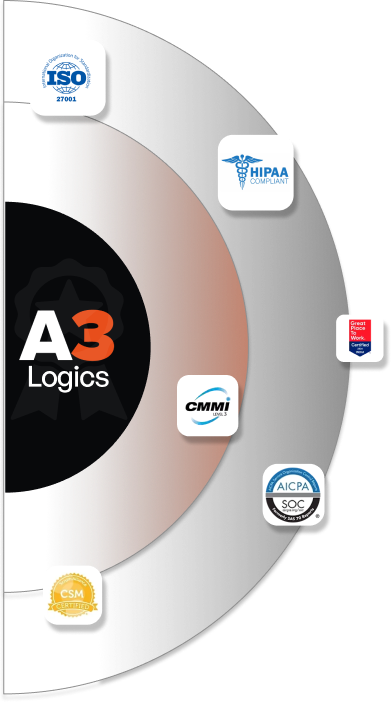Our working world — like so many areas of our lives — is experiencing extraordinary change. Similarly to how we live, connect, and shop, the way we work is evolving and final forms are still undetermined. Even so, we’re confidently declaring that our work landscape is likely to stay in-step with global digital transformation. After all, so much of the changes to work this decade were responded to with technological solutions and strategies.
One industry that is also inextricably linked to this enormous global industrial change is human resources (HR) companies. Due to their worldwide operations and localized impact, HR companies are experiencing this change firsthand while adjusting to unprecedented challenges. At the same time, HR companies are major drivers of another key economic vertical: human capital management (HCM) software. Not only do they use these tools but also their adoption of these platforms enables their work. This reciprocal relationship, particularly with technological giants involved in this software like Microsoft, has economic, industrial, and international significance.
Subsequently, this A3logics blog is diving deep into the enrollment software niche and how it directly shapes HR businesses. Notwithstanding this, because the USA is a labor market leader, this piece focuses on their best HR companies. Specifically, understanding why USA HR companies leverage enrollment software to empower their teams and improve employee experiences.
Table of Contents
Therefore in this article, we’ll explore how USA HR companies use enrollment software in their business to achieve dynamic outcomes:
- Driving employee engagement
- Improving organizational security
- Protecting high-level stakeholder data
- Bolstering employee benefits enrollment
- Strategizing for digital transformation
- Strengthening best practice
- Complying with the Health Insurance Portability and Accountability Act (HIPAA)
Now let’s explore the market of USA HR companies and how the best in class are using enrollment software today.
The current state of the business market in USA for HR companies
Firstly, let’s review the current state of the HR business market in the USA.
Overall it’s well-known that the Covid-19 period profoundly impacted the USA labor market and how they work. For instance, the first global lockdown of March 2020 saw around 6 in 10 US workers shifting to remote conditions. From here, as the health threat shifted, a new outlook towards working conditions and flexibility emerged, due to technology capabilities.
Since the pandemic started, two words have consistently been used to illustrate its impact for businesses: digital transformation. The digital transformation facilitating remote work — technological tools for collaboration, meetings, and conferencing — led to a new working normal.
USA HR trends from 2020 to now
Almost four years since the pandemic began, hybrid work and entirely remote teams is largely common. In fact, as of 2023, around 27% of USA employees are remote. For USA companies, remote work spiked in 2020 though current numbers exceed those of 2021. Moreover, right now around 66% or two in three employees work remotely part-time. Additionally Zippia projects approximately another 10% (36.2%) will be remote by 2025. And, on a whole market level, their reporting found that 16% of USA companies are fully remote.
Altogether these remote work figures are only part of the picture. Significantly this is because some industries can never entirely be remote (around 60% of USA workers). Concurrently whole other market segments aren’t experiencing digital transformation quite like this to facilitate remote work and offices.
Markedly there is a complex shift in outlook towards work that carries over to evidence-based data. For instance, USA businesses are, like other countries, experiencing phenomena including “The Great Resignation” and “Quiet Quitting”. Nevertheless CNBC explains that shifts are more nuanced than nomenclature suggests with many employees changing professional trajectories for new roles. Greg Iacurci writes “Quits are therefore a barometer of employee optimism about their ability to find new work.”
The HR and employee change costs for companies in USA
So with this impact on businesses, are there flow-on costs?
Interestingly, as mentioned earlier in this article, HR has close ties to 2020s changes in worker preferences and working styles. Concurrently the qualitative value of HR also came very clearly into view during the pandemic. Specifically, businesses inescapably saw the contributions these teams make within companies or as business-to-business (B2B) stakeholders.
During the first years of this decade, namely with pandemic disruptions, HR teams experienced ongoing pressure in three ways:
- Recruitment becoming entirely virtual
- Unpredictable staffing budgets
- Remote teams requiring extensive support
Since then, this pressure may have abated however the consequences remain. Though the dust has settled, the post-Covid-19 world is irretrievably different from the pre-2020 HR landscape. When it comes to building a sustainable, resilient future, HR is at the centre of this and thus, employee teams.
The four factors driving rebuilding the HR market and companies in USA
- Economic recovery — The economy is recovering and it’s pouring money into businesses so they can hire more staff.
- Renewed labor market — Revitalized investments are enabling businesses to make competitive offers and workers are responding; many people are pivoting to new roles.
- Restarting of industries and jobs resuming — Not only is there more many back in the labor market but also industries closed during the pandemic are resuming.
- Human-centric employee experiences — Lastly workers are seeking more in this era and they’re not afraid to move around to find it. Though data shows USA workers are actually highly engaged compared to global figures, they are seeking holistic remuneration and care.
Why HR companies in the USA are guiding business recovery across industries and in technology-spending
Basically the pandemic demonstrated that HR personnel, quality hiring and retention, and the people making up businesses are vital. Accordingly, Jeanne Meister explains for Forbes that in the USA, HR leaders are approaching recovery with a focus on employees. “With the growth of the digital economy, our ‘always on’ way of working, the stresses in managing work-life integration, and now dealing with the coronavirus, assisting workers with their wellbeing has never been more important.”
In 2023, Gartner found businesses are spending the following on HR-related activities:
- HR technology — To support and progress digital transformation for core HR administration.
- Staffing and recruiting — Using technology tools to improve and finesse hiring in a competitive labor market.
- Total rewards — In addition to recruitment challenges, there’s pressure to offer winning remuneration that responds to inflation while boosting staff wellbeing. This investment attracts talent and ensures they’re holistically cared for.
- Learning and development — Making whole-career growth is a necessary priority to retain high-quality talent and meet employee expectations. Similarly to the other points of spending, this requires HR software that delivers exceptional learning and development (L&D) experiences.
So with these four spending areas, what we can determine is two things:
- HR teams need quality tools for all their operational activities
- The best companies are investing in these for their teams, stakeholders, and growth
How HR companies in USA affect the global enrollment software market
Now that we’ve reviewed the current USA HR market, let’s review this against the global HCM software market. At present, dedicated Statista reporting found the global HR software market had a revenue of $62.2 billion USD in 2022. When growth projections are taken into account, the market is predicted to increase to $91.8 billion by 2026.
In order to attribute this growth, Statista emphasizes the combination of:
- Increasing number of hybrid or remote organizations post-Covid-19
- Incumbent technology HCM software giants like ADP and LinkedIn (owned by Microsoft)
- Technology startups like L&D company Udemy
- Widespread digital transformation as a business strategy for recruitment, hiring, performance management, collaboration, remuneration systems, benefits enrollment, and training.
Growth in the market and rapidly proliferating use exemplifies why the global HR technology vertical is booming. Equally software is cloud-based or on-remises and suitable for all business sizes — large and small-medium enterprises (SMEs). When we review the global employment and operational challenges of the last four years, these tools fortify businesses. Accordingly Patrick Thibodeau reported in in early 2022 in TechTarget, “HR tech spending is rising, thanks to the ‘Great Resignation,’ and a need to invest in automation technologies such as chatbots and RPA to handle increasing workloads.”
How the USA market and its HR companies have influence in global HCM software use
Furthermore the USA as the largest market of North America is influencing global industrial trends. Allied Market Research forecast reporting on the HR technology vertical for 2021-2031 states, “Region-wise, the HR technology market was dominated by North America in 2021 and is expected to retain its position during the forecast period, owing to rise in focus on business process improvements and enhancing HR analytics capabilities offered by human resource technologies vendors.”
What this tells us is that if their market is booming, this will likely have global reverberations. Specifically, the USA retains almost one-third of the world’s information and communication technology share — they account for almost 36%. Comparatively, the European Union (EU) and China each hold over 11% as the respective second and third biggest regions. Undeniably as revenue creators, major consumers, drivers of innovation, and contributors to trade, the monolith USA economy shapes global trends. Finally, many leading global HR companies are headquartered in the USA so early adoption tends to start and spread here.
What type of HCM software do HR companies in USA use
Chiefly, it’s exceedingly important to understand the types of HCM software the HR companies use in their businesses.
Understanding the different kinds of software HR companies in USA use
Overall, these types of HR systems are all used for HR operations. Choosing a solution depends on specific organizational needs and achieving the goal of improving processes. Certainly these systems are valuable however leading USA HR companies have a clear sense of their objectives and maximizing tools.
-
HCM Software — Human Capital Management System
What it is:
This software helps businesses is designed to derive maximum value from teams to target the company’s competitive edge. HCM software comprises core HR functions into the system capabilities.
Key components:
- Administrative functions
- Company data
- Talent management
- Labor and workforce management
-
HRMS Software — Human Resource Management System
What it is:
This software is dedicated to boosting organization-wide productivity. This tracks, analyzes, and produces insights into employee contributions. Then HR provide this data to management to determine organizational trends and resource management.
Key components:
- Payroll and tax compliance
- Attendance
- Benefits administration
- Self service
- Employee directories
Of these three HR software types, the simplest way to evaluate the value of each and comprehensive functionality is:
- HRIS covers all essential HR processes dealing with organizing personnel information, payroll, and benefits administration.
- HRMS is significantly more comprehensive with infrastructure that supports team productivity in addition to having all HRIS features, too.
- HCM software is the most robust of the three systems as it is highly strategic because it extends HR capabilities. Moreover, HCM has additional functions like onboarding, performance management, global compliance, HR analytics, position mapping, plus HRIS and HRMS capabilities.
Of these three systems, HCM system has Enrollment Software functionalities. Therefore for the purposes of this article, we determine this is what the best HR companies in USA are using.
What HR companies in USA need their enrollment software tools to have in 2023?
At present, as we’ve already discussed, HR companies in the USA have their work cut out for them. After all, it’s a time of digital transformation, economic uncertainty, regional and global recovery, and cultural change. Hence — and with Gartner reporting most organizations spend between $1,350-$3,800 on HR functions per employee — every software dollar counts.
Unquestionably in HR organizations, these are the tools invested in to make and save money. Concurrently Gartner emphasizes that technology needs to be tactically used to improve and not just automate HR activities. “HR leaders can create efficiencies by implementing human-centric technology solutions – such as skills management or learning experience platforms – to maximize employee experience, retention, collaboration and performance outcomes.”
So right now HR companies in the USA need their enrollment software to:
- Uphold cybersecurity and data protection standards while upholding compliance
- Foster strong, competitive hiring and retention
- Support 21st century work standards
How do HR companies in USA use enrollment software for compliance best practice?
Thus for the final section of this article, we’ll concentrate on how USA HR companies use software in achieving this.
How USA HR companies use enrollment software in user and organizational security best practice?
Following on from the previous section, we’ll now drill into the first fundamental component of this software best practice. Specifically, HCM software’s leading strength is how it supports HR companies to meet compliance obligations.
How do USA HR companies use enrollment software in their compliance activities?
- Compliance — All HR companies need to meet compliance standards around remuneration, industrial laws, and fulfilling contractual obligations.
- HIPAA — Specific for USA HR companies are their compliance obligations for this law that protects USA workers’s health insurance coverages. Both protecting data and complying with HIPAA is a mandatory law.
- Data privacy — General data protection is now globally understood to be a core human right for all people and in all contexts. Businesses and especially HR companies who handle significant volumes of private information are particularly accountable in this area.
Why is HIPAA crucial in compliance for USA HR companies?
Since 1996, USA businesses have been obligated to protect the privacy rights of individuals working in the USA. According to HIPAA Journal, “The HIPAA Privacy Rule defines what constitutes individually identifiable health information and how it should be protected from unauthorized uses and disclosures.”
What does HIPAA cover in compliance terms?
The HIPAA law is designed to protect health insurance access for USA workers and minimize insurance-related fraud. Moreover it protects the right to actually access health insurance, for example remuneration package benefits, and privacy around healthcare access.
Why is HIPAA in compliance processes for USA HR companies?
Because the best HR companies in the USA offer comprehensive benefits programs with extensive health options, teams handle health data. Despite this, HIPAA is a complex law that doesn’t necessarily apply to employers — including USA HR companies. Nevertheless, at the current time there is no federal USA laws for data protection though there are privacy laws. Accordingly then, USA HR companies are generally using enrollment software that supports HIPAA compliance even when it’s not contextually applicable.
Another reason why HIPAA compliance matters to USA HR companies and is part of their enrollment software is risk management. Significantly, one requirement of HIPAA is that it requires businesses to evaluate their administrative, technical, and physical security safeguard protocols. This is because a HIPAA healthcare privacy compromise can result from a general data breach. For instance, Lisa Hedges reports for Software Advice that healthcare data security is among leading priorities for USA HR companies. “In our Healthcare Data Security Survey, we found that nearly half (49%) of the practices that experienced a data breach did so as a result of human error.” Above all then, for USA HR companies they do need to be risk managing through software choices supporting HIPAA compliance.
Why the best HR companies in USA prioritize enrollment software for compliance, HIPAA, and cybersecurity?
Obviously then, for the USA market generalized compliance obligations and HIPAA overlap. In fact, Forbes experts Dana Miranda and Cassie Bottorff itemize that best practice for HR compliance comprises:
- Practice Policy Documentation — Keeping all employees informed, trained, and clear on compliance responsibilities.
- Literacy In Regulations — Ensuring everyone is current with federal, regional, and global obligations. Specifically in the USA, HR companies prioritize understanding and referencing key governmental resources in Equal Opportunity, Labor, and HRM.
- Investing In HRM Software — Incorporating robust professional systems into operations, especially for HR companies, facilitates end-to-end processes and that includes compliance.
- Employee Transparency — From day one, businesses — including specialist USA HR companies — must maintain a non-negotiable culture around compliance. To list, this includes formal training that is regularly maintained and documented along with normalizing industrial legislations in everyday HR.
How USA HR companies use enrollment software in all levels of compliance?
Likewise, for USA HR companies there are ongoing existential threats to compliance. Whether it’s privacy violation, physical or digital attacks, the dynamic impact and costs are extensive and stretch into the millions. Nevertheless HR companies in the USA can use their enrollment software to fortify compliance for cybersecurity, data privacy, and HIPAA.
-
Cybersecurity
Forthwith this is a huge threat not just to compliance but the entire health of companies the world over. Emphatically if cybersecurity is compromised — through breaches or attacks — there are extensive tangible and intangible costs. Notwithstanding the HR industry, with so many individuals being vulnerable, the fact also remains that cyberattacks cost USA companies more. Cybersecurity strategies are supported with enrollment software infrastructure. For example, encrypted systems protect data and cloud-based software-as-a-service (SaaS) are harder to attack.
-
Data privacy
Because data privacy can be compromised through a cyberattack, cybersecurity failures, or poor digital hygiene, protecting against data breaches matters. Therefore USA HR companies need to leverage the built-in data privacy measures like authorized access and data audit trails. Enforcing these compliance strategies for all users across all users then these businesses remain operationally nimble while maintaining data protections.
-
HIPAA
When USA HR companies use HCM software then they can opt for the highest level compliance features. Undoubtedly having HIPAA compliance frameworks in place keeps all stakeholders — and the company — protected. Even so, HIPAA Journal emphasizes that this compliance requires tactical planning so companies must ensure IT and HR collaborate here. Specifically, “An IT manager is usually delegated as the HIPAA Security Officer, and it is their responsibility to ensure every department within the company is compliant with the Security Rule.” Despite this, HR personnel — even in a HR company — can use HCM system features to take HIPAA initiative. For example, HR planning with IT who has accountability for which HIPAA compliance areas and regularly meeting to review operations.
How USA HR companies use software tools in employees engagement strategies
To that end, let’s finish with discussion of how employee engagement is targeted, supported, and nurtured in USA HR companies. Because HR is ultimately all about people, it makes sense to briefly review how USA HR companies engage with software.
10 ways HR companies in USA are engaging employees using HCM software
1. Competitive recruitment and retention
Enabling better, more intelligent recruitment engages employees in two ways. Firstly, it properly invests in building solid teams and meaningfully finding recruits who will add to a team while thriving. When 30% of employees leave within 90 days then replacing them being 33% of their salary, hiring processes quantifiably impact. What’s more, companies with a high staff turnover generally often have culture problems that affect both resigning and staying employees.
2. Workflow
Next, workers are more engaged when they’re using robust systems that support them achieving their work. Without this, morale and actual business tasks suffer. Due to the all-in-one design of powerful HCM systems, HR tasks are simple and people stay focused.
3. Collaboration
Similarly to workflow is how enrollment systems — especially cloud-based products — promote collaboration among team members. This creates a positive team environment and because it’s happening in systems, there’s options for third-party software integration. For example, leading HR software companies offer integration with productivity software like Slack and Zoom.
4. Flexibility
Since the pandemic many more teams are hybrid with team members who are remote either part-time or full-time. The accessibility of HR software enables remote collaboration and simplifies staff working according to their preferences. This kind of ease is part of forward-thinking, progressive HR culture across all industries — including HR.
5. Transparency
Even more than flexibility, there’s the transparency and trust that HCM software encourages among teams. Though management and senior HR personnel can monitor performance and engagement metrics, using systems for operations communicates open company culture. Accordingly employees know there’s good faith for them to get the work done and check in with HR when needed.
6. Personalization
Moving into the technical side of user-experience and user-interface, HCM software is increasingly a tailor-made worker experience. When artificial intelligence (AI) and machine learning are integrated, users can be more productive and systems work for them. For instance, they receive benefits recommendations or the system might analyze if they drop in output. Even the worker may not realize and instead they can request training, support, or workflow recommendations from the intelligent tools.
7. Fairness and inclusivity
Coupled with transparency, the opportunity for workers to be using tools that promote ethical operations and culture is consistently important. Therefore systems that are designed to support this at every level — from hiring to remuneration and benefits — are engaging. When this is core to systems and organizational values then this integrates with compliance and encourages bias-free, equal opportunities.
8. Better benefits
By the same token, systems that facilitate better benefits from remuneration package design to administration also build company fairness standards. For instance, engagement in the post-Covid-19 era is linked to employee engagement and companies are taking notice. Hence businesses are offering more holistic benefits and not just salary plus health insurance. Along with personalization, benefits can be tailored using existing employee data and preferences logging to boost offers, too.
9. Learning and professional development
Gartner research shows that “L&D offerings are not keeping up with the pace of change” to properly engage workers. Especially with research showing less than half (45%) of employees feel that their workplace provides education relevant to them. With comprehensive HCM software, employees gain a world of end-to-end training. Whether it’s onboarding and induction or ongoing training and professional development, these custom systems are consistently available to engage employees.
10. Health promotion
Another important facet to inclusivity is in holistic wellbeing as this creates a foundation of safety and acceptance. Then this leads to employees being able to flourish and thrive. Prior to these offerings, employees often suffered in silence or felt that their wellbeing was unimportant. Now that companies recognize the links between employee wellbeing and building teams with longevity, HR can support staff any time. This can be through check-ins and coaching or it can be supporting staff to access telehealth — via HCM systems.
Conclusion
In conclusion, USA HR companies are understandably hugely influential in HR, business, and industry both in North America and internationally. As they’re operating in a HR software market currently worth $14.8 billion, there’s still growth to happen. Despite everything we’ve covered in this article, this growth happens with an investment in software that helps achieve organizational goals. Accordingly, businesses even those that aren’t HR can invest in their own HCM software solution. Start with an A3logics consultation where experienced enterprise software developers evaluate the right HR infrastructure for your business and industry. Then get set to beat the competition and innovate beyond the business, industry, and strategic objectives.
Frequently Asked Questions (FAQs)
Why do HR companies in USA opt for enrollment software?
Leading HR companies in the USA understand the robust functionalities of enrollment software and how these improve their operational objectives.
For example, enrollment software helps HR companies and teams undertake:
- Payroll and remuneration
- Benefits enrollment
- Compliance
- Talent management including recruitment, hiring, training, onboarding, and performance management
- Workplace safety
- Personnel data management
Therefore using all-in-one benefits administration software systems is a way to streamline operations, boost accuracy, fortify security, and maintain compliance.
Do HR companies in USA use enrollment software for Human Capital Management systems
Overall, it’s only possible to definitively define the HR software used in leading USA HR companies with reporting data. Even so, a HCM system encompasses the widest range of enrollment software features essential for HR operations in the USA. Therefore because a HCM system is designed to incorporate all essential as well as advanced operational objectives, it’s strategically logical. Learn why this can fulfil all end-to-end HR needs with a software development consulting company and roadmap evaluation.
How do HR companies in USA use enrollment software for compliance best practice?
Overall, compliance standards in USA generally fall under areas tied to privacy, equal opportunity, industrial standards, safety, and data protections. One leading area that is specific to the USA HR region is HIPAA. Due to how comprehensive enrollment software is, specifically HCM software that incorporates all compliance obligations, these systems support best practice. Along with well-managed and sustained frameworks, policies, and training, HR companies can enable compliance using HCM software tools.
Do HR companies in USA use AI in their enrollment software?
AI technology is already in use throughout leading enrollment software providers to streamline tasks and improve accuracy. For example, HR companies in the USA have used AI in their hiring throughout the last decade. Currently, AI is being used in HCM software to support personalized UX/UI, data analysis, cybersecurity, and benefits enrollment.






